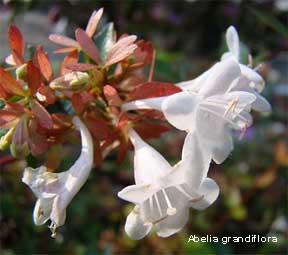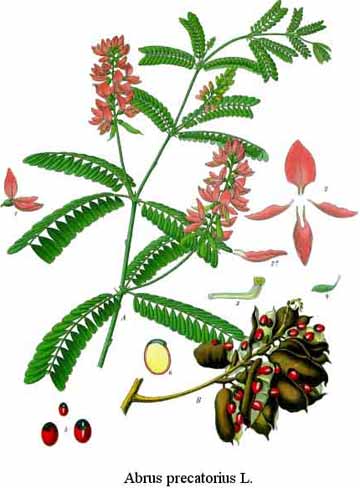ABELE (a-beel’ or ay’-bel). A name for the white poplar (Populus alba), a large tree with coarsely-lobed, triangular leaves, hardy even along the N. Atlantic coast. Its var. nivea, with leaves white and cottony beneath, is sometimes, but wrongly, called “silver-maple.”
ABELIA (a-beel’-i-ah) – Native of Asia and Mexico, this genus of several small shrubs, with few exceptions is not hardy in the North. They thrive best in a sunny, sheltered location, with a well-drained sandy loam soil, containing plenty of organic material or with a soil with peat worked in, to encourage growth. Flowers are rather small, tubular or bell-shaped, abundantly produced in summer on young growth, and vary in color from white to pink or rose.
Cuttings taken in late summer root readily under glass. Young plants wintered in a cool greenhouse and planted out in spring grow and flower well that year.
Species

Abelia engleriana – from China, hardy in Mass., grows from 3 to 6 ft. and bears rosy-pink flowers in early summer.
Abelia grandiflora – To 6 ft. A semi-evergreen hybrid, the leaves taking on a lovely bronze tone in fall. Flowers, pink and white, from June to November. Wood injured by severe cold.
Abelia floribunda – A handsome evergreen from Mexico. Not hardy North of Washington, D. C., but sometimes grown in a cool greenhouse. Flowers larger than most, nodding, purple-rose, blooming in June and July.
ABIES (ay’-bi-eez). Botanical name of the genus Fir, large evergreen conifers of the Pine Family, some species native to U. S. and a number valuable as ornamentals, especially when young.
ABOBRA (a-boh’-brah) – A tropical, tuberous-rooted, flowering vine, suitable for greenhouse culture.
ABRONIA (ah-broh’-ni-ah). Sand-verbena. Low or trailing native herbs with fragrant white, pink, or yellow flowers. Grown as annuals and good for open, sunny places in light soil, or for vases, rockwork, and baskets. Sow seed, after peeling off the husk, outdoors after danger of frost ; or in pots or frames in early fall for planting out the next spring. In mild climates plants will survive the winter or may self-sow.
Abronia tumbellata, 9 in. tall, with pink flowers, is the best known species; Abronia latifolia, prostrate, has yellow flowers, and Abronia mellifera is a stouter, white-flowered Pacific Coast form. Blossoming all summer, the plants are pleasingly fragrant in the evening.

ABRUS (ay’-brus). Tropical creeping or climbing woody herbs grown in the S. for screens and sometimes in greenhouses for ornamental effect and the interesting, bead-like seeds, which, however, are poisonous.
Raise from seed (preferably soaked before sowing), or from cuttings rooted under glass. Arbus precatorius, to 10 ft. but usually trailing, has white to rose flowers and scarlet, black-spotted seeds.
These are used in making Buddhist rosaries, hence the plant’s common name, Rosary-pea. It is also called Crabs-eye vine, and, sometimes, Weather-plant because it droops or “goes to sleep” during storms.
ABSINTH (ab’-sinth) or ABSINTHE. The shrubby, aromatic, herb Artemisia absinthium; or, more correctly, a strong alcoholic, highly-intoxicating green liquor made from it.


ACAENA (a-see’-nah). An attractive group of more or less trailing perennial plants of the Rose Family, used in mild climates in the rock garden or as a ground-cover over bulbs. They are occasionally grown in the North if winter protection can be given. They are used principally on account of their attractive divided leaves and bristly fruits, for the flowers are quite inconspicuous. Easily propagated by seeds, division or cuttings.
Acaena argentea from Chile has a creeping stem and silvery leaflets. Acaena microphylla (New-Zealand Bur) has stems that hug the ground and rounded heads of flowers with purplish-red spines. There are species native in California.


{ 0 comments… add one now }
You must log in to post a comment.